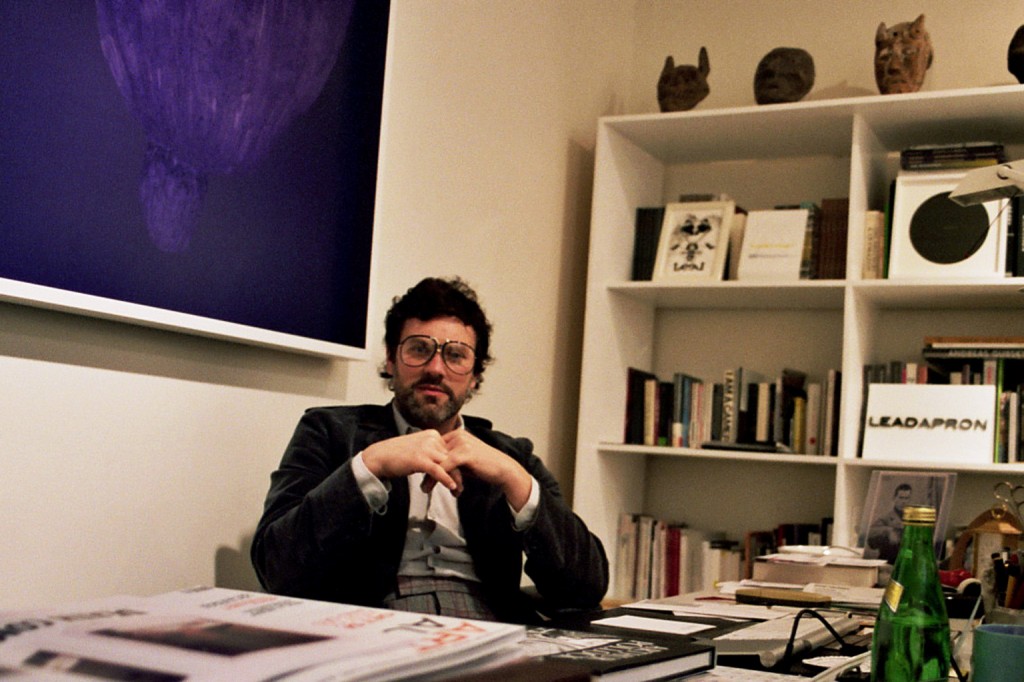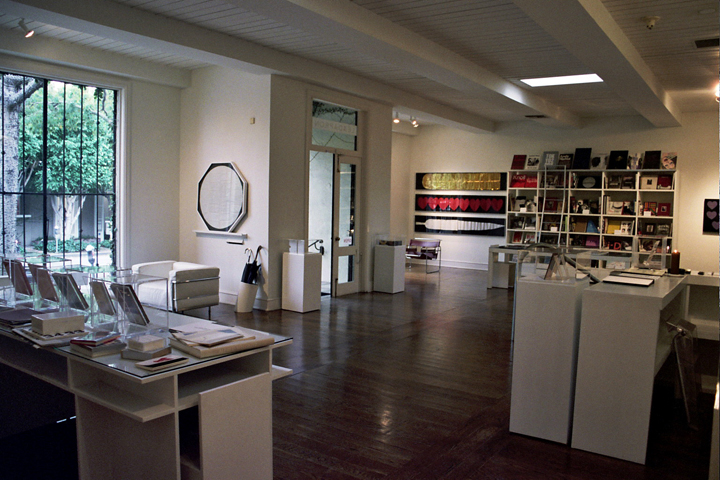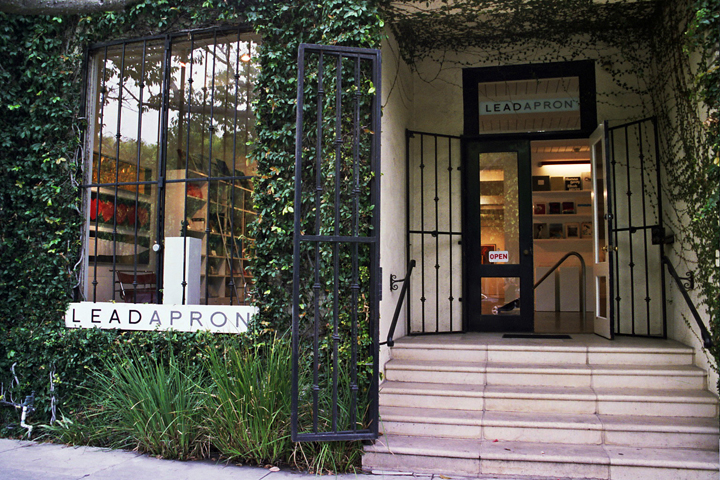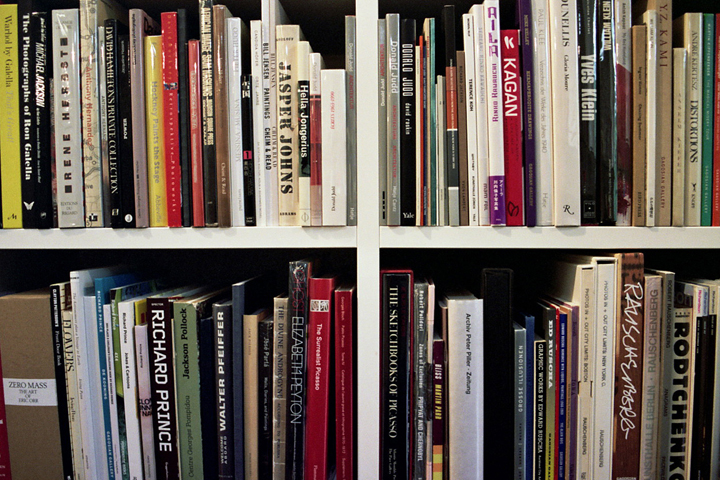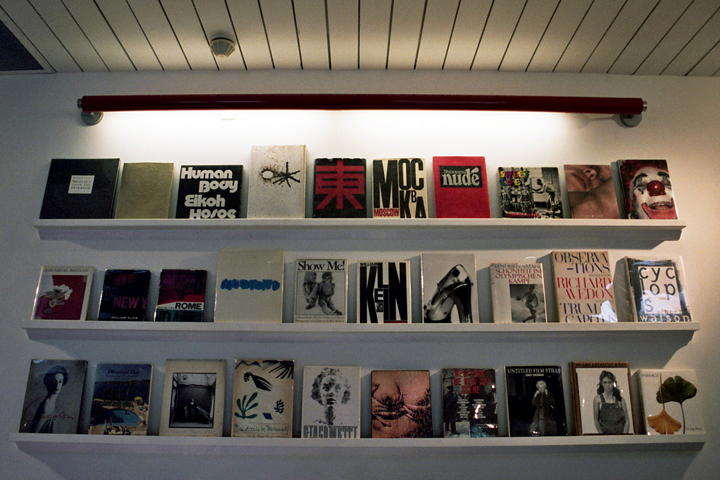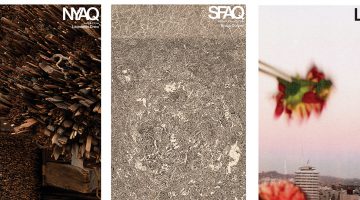LEADAPRON
A conversation with Jonathan Schilder Brown and Jesse Pollock
I have moved more times in my life than I care to remember. I have packed my belongings again and again, while feeling the boxes gain more weight each time. Eventually I realized that the brunt of the weight always came from an ever-growing collection of art and photography books. While I was able to shed the paperbacks and literary tomes I had amassed over the years, I was never able to part with an artist or photographer. Each limited monograph was a work of art itself and as the collection grew I always longed for a way to share them with people. Book dealer Jonathan Schilder Brown has created something special with his store LEADAPRON by doing just that. Coupled with an ongoing schedule of gallery shows, which are housed under the same roof, LEADAPRON contains first edition and limited monographs from masters of contemporary art and photography. By making the change from private dealer to retail space, he has given the public the ability to take in his impressive collection, which in turn has created a different type of bookstore all together. With his engaging nature and boisterous conversation, Jonathan has always been a pleasure to talk with. He was kind enough to sit down for a couple of questions and tell us about parting with objects of intense desire, how psychology relates to bookselling, and the secret to getting x-rayed.
I recently read something that referred to you being a neuropsychologist. Is that a throw back to an earlier part of your life, or was that a title bestowed on you for your ability to see how the brain reacts to artistic stimulation?
I spent 15 years working in the field. Initially, I was drawn to what Walter Pater referred to as the “Romantic Sciences.” Like many young and idealistic people who have artistic leanings I was interested in what brain damage, disorder or other congenital afflictions or sustained injuries would reveal about the normal functioning brain. As we really don’t have any clue how the brain works, it helps to look at the brain gone awry and piece it back together. I was interested in determining what at the time I called “portraits of identity,” which were themes that ran throughout thought and thinking, behavior, perception, memory and the like…wanting to get to a root understanding of human nature, drives, desires, etc. Most people ask the basic questions about existence and can see the artifact that is culture and experience love and pain and express their creativity and there I was in the midst of every disorder in the annals of neurology and psychology looking for answers. At the time I had aspirations of being a writer. I saw the exquisite prose of the Russian novelists in terms of understanding human psychology and people like Samuel Beckett or Harold Pinter with their schizophrenic language and Guignol’s band of characters. All of which really appealed to me and I thought I’d find that kind of material in a psychiatric hospital. However, I wound up living the experience instead of writing it. I use to use Oliver Sack’s office and see his patients to conduct tests and they would greet meet as “Dr. Sacks.” I became “The Man who mistook himself for Oliver Sacks.” So to answer your question, I wasn’t a full-pledged Ph.D neuropsychologist (though I functioned as one), but a philosophy student who felt that theory was gray and that evergreen grew from the tree of life. So I went into the enchanted forest only to stay there for 15 years.
I find it fascinating that so many people I meet who are involved in the arts have come from a background similar to your own. I can’t help but draw some parallels between having a greater understanding of how mind works, and following that path directly into creative pursuits. Do you think that you would have felt the same pull to what you do now, if you had not seen first-hand how people react to that sort of stimulation?
That’s a good question and sort of a crystal ball question too. I explored many different disciplines, but ultimately they all had to do with similar themes. I would say that creativity is something that always astonishes me when accompanied by beauty. I was headed in this direction… to surround myself with the handicraft of the mind… I like when someone spins flax into linen or from the kernel of an idea makes an arresting or elevating work of art. I was born appreciating beauty in nature, in people, in actions, in music and the arts, etc. I was drawn to it. I stood behind it as a bulwark against and to face the fears and anxieties that come with being alive and now many years later champion creativity and beauty as a language and a way of life, or in response to the challenges of life. Nietszche said were it not for art we would all die of reality.
When you are dealing with stock of an item (like a rare book) where the quantity may be the only remaining copy, does it become hard to run and stock a full bookstore?
Yes it does. But there are a variety of “only remaining copies” and that’s what keeps it interesting. If I had to stock a full bookstore with every new title that just came off the press I’d be in trouble. Those types of books are printed in the thousands and can be had everywhere. What I like to concentrate on are the sole copy, or the association copy or the handmade or personalized. The Rosetta stone so to speak.
When it comes to purchasing books for your catalog, is there a discerning eye when it comes to deciding what makes the cut? For example, do you only sell first editions, or is it more a matter of whatever is still in existence?
It’s a combination of what I like, what I feel is important and then what I think people will want. I use myself as a gauge of where I feel the collective interest is heading, call it intuition or providence.
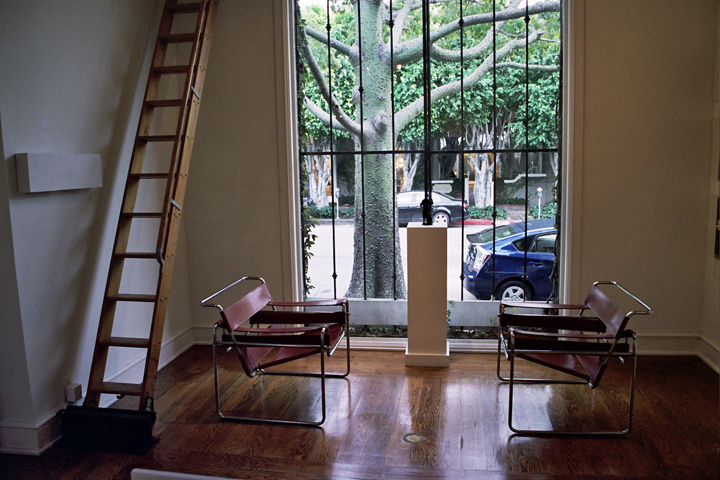
Does that mean that we’re likely to see a brand new copy of the Terry Richardson x Lady Gaga book on your shelves if you sense a demand for it? Or is that collective interest still kept within certain barriers having to do with rarity and collectability?
I bought the book because I think both TR and LG are incredibly talented. I just wanted to look at it and perhaps through looking, apprehend something about the time I live in. It wouldn’t necessarily be the kind of book I would carry unless it was signed or doctored up in a special way by the artists. If you’re asking whether or not I’d run out and buy ten copies to sell in my gallery the answer would be no. It’s not because I don’t think it’s a great book, but because it is too common and widely available and I would feel that I should buy ten copies of the next hip book and so forth. It’s not my model.
When going after a full collection to add to your catalog (like your astounding Basquiat collection), do you find that it’s the product of hard work – piecing it together bit by bit, or is it more often a happy coincidence – like someone approaching you or finding it at auction?
I rarely find anything good at auctions and tend to overpay. Plus, everyone knows what’s being offered so it doesn’t make much sense to buy it, unless I want to sit on it for a long time. I am transactional. I like to sell and often just want to take a little song out of a sale and leave a lot of music in the book or object or artwork for the next person to enjoy. I just say “I want a collection” or pick an artist (or many) and go on the hunt for everything I can find. People bring me books or I trade. I have been very fortunate to find myself in the right place or speaking with someone at the right moment. I am also a social dealer meaning that I actively make myself available to clients and collections. I don’t just sit and wait. It’s the unswerving punctuality of chance and legwork. I have eyes and ears everywhere.
Given that I have a near-obsession with collecting photo books, I can safely say that I would rather move apartments every day for a week then sell my copy of say, Larry Clark’s Teenage Lust. Even though you have made a living selling books, how can you bear to part with such rare and individual works. Does it ever eat you up inside?
I suppose that I couldn’t really be a dealer if that was the case. You have to practice loss and letting go. It’s a healthy practice in life.
Given the previous two answers, it sounds like rare book game must be a very zen-like pursuit. You obviously take great pleasure in the hunt, and tracking down collections piece by piece. If you have come to terms with letting those treasures go after finding them, it must be akin to the Tibetan sand Mandalas, which are simply swept away after weeks of work. Or I suppose I could compare it to the Indiana Jones model, where he was happy as long as it existed somewhere, someplace. When you let go, do you take comfort that it’s somewhere else, or is it gone from your mind completely?
Nicely put… you add a very romantic lure to what I do. There is a reason we call these objects “old friends” in the trade, as sometimes we see them again or think of them from time to time with a fondness. I know where most of these “friends” are and for the most part take some comfort knowing they are well looked after.
On a somewhat related note, Los Angeles is often a place where celebrity can create commodities and generate a market where people may be buying the next hot thing for the wrong reasons. Do you find this ever to be the case with rare books and maybe in a greater sense, ephemera? Does that ever bother you, or at the end of the day is that just the cost of doing business? And really, if celebrity generates ephemera in the first place, can that that scenario even be judged?
I honestly haven’t experienced this.
Certainly you can agree that this exists in certain arenas (art buying for instance). When you say that you haven’t experienced this, do you mean as it pertains to rare books, or in Los Angeles in general? What I was getting at was: do rare books share the same qualities as say, a Banksy show, where it becomes a celebrity event and can set buying trends? Do people approach you wanting to own the whole Lee Friedlander collection in order to have it on their coffee table to be seen? The line blurs at times between art and celebrity (as many feel it did with Basquiat) so I wonder if this ever manifests itself within in your practice. And feel free to tell me if I am way off base…
People buy rare books for a variety of reasons. Status could be one of them. There is nothing like a beautiful and thorough library filled with some of the greatest achievements of humankind. Again, I don’t feel that the rare book market is influenced by hype. These books are works of art and it takes a sophisticated and elevated type of person to acquire them. When I say elevated I mean someone that is sensitive and thoughtful and conscious with an aesthetic and with desire and an appreciation. These books are not inexpensive either so even if a trend were ablaze people would still need to understand why they are spending $500 to $200,000 on a book. I sell to celebrities and people buy books from me to give to celebrities, but that’s about it unless I am completely missing something. If a movie about Basquiat (like The Radiant Child, which in part was shot in my first gallery and included photos by Basquiat that I had) is released then perhaps a few new faces will appear asking to see Basquiat books. Likewise, if a famous artist dies then I might sell a few of their books, but that is the extent of it. The rare book market sort of hovers above and occupies it’s own air… that’s been my experience. The rest is like politics that change from day to day.
There seem to have been quite a few booksellers popping up over the years on your stretch of Melrose. Obviously you are quite set apart from stores like Assouline and Book Marc, but what was your reaction to becoming neighbors with so many potentially conflicting stores around LEADAPRON.
I tend to have a different reaction to competition than perhaps my other colleagues might. As far as I am concerned the more book stores that pop up prove that people buy books and that book collecting is still in its infancy. I felt that Book Marc was complementary and ultimately good for my business. We often send clients back and forth. If I don’t have something the client is looking for I will send them to Book Marc and vice versa. The people at Book Marc were very nice and came here to sort of check with me to see how I felt and I gave them a very warm reception and welcome. There is a solidarity and mutual respect. If you go to a souk in Morocco, there will be hundreds of vendors selling the same items and somehow those traditions and families of those merchants continue to survive and carry on. In the case of books, however, and not to be immodest, I do feel that what we have here at LEADAPRON is quite unique. There are few places in the country, if not the world, where you can go and touch and handle and even buy what we have. Assouline makes nice books, but they are common and unfortunately they have closed shop on Melrose Place. It’s also a law of attrition and attraction: If you present the best material, can keep your doors open and love what you do, you will find success in a way that is meaningful to you.
With the overhead that often comes along with opening a retail space or maintaining an office, what made you make the change from a private dealer to where you are today? Are there any glaring drawbacks or benefits from either?
I always wanted a gallery so it was just the direction I moved towards. Clearly you have enormous flexibility that comes with running a space that obviously you don’t have working privately. However, as a private dealer you also have a certain freedom. If this is my ship then I can’t easily step ashore and just lie on the beach. Private dealers can do that, but then they can’t always get a ticket to ride the high seas. Just extend the metaphor…perilous and joyous moments.
Forgive me if I have this wrong, but the gallery came a bit after the shop was open, correct? Was the gallery part of the plan since the beginning, or did that come around naturally as an extension of the bookselling? As far as the exhibitions go – when you are curating, is there a standing theme that runs through all of your shows and is there a relation to your stock and what ends up on your gallery walls?
My first space had a gallery. In fact when I was dealing out of my home that was a gallery as well. I began by showing artworks that were generated from books or the artwork that was created to produce the book. As I move into the future, the shows will be of a similar quality to the rare books or anchored in them in so far as they will be very specialized (not multi-editioned shows), unique, powerful and most importantly: beautiful. I am currently most interested in conceptual art, furniture, sculpture and more abstract painting. I want to show things that are immeasurable, yet where you can capture the intention of the work accurately off your nervous system before critical analysis comes into play.
Almost as beautiful as the books you stock, is the shop itself and the building in which it’s housed. Can you tell us a bit about the former Rose Tarlow showroom, which LEADAPRON is located in?
I was only in a few times. I remember thinking “I want this to be my gallery someday.” Rose Tarlow is a colossal talent, a wonderful person with a magnificent eye. You can only imagine that everything she does, she does with excellence. Like Lord Byron says, “she walks in beauty.” Rose’s largess is the main reason I am here to begin with. A twist of fate. If you want to get an idea of just how good she is, you should drop into the new Rose Tarlow Melrose House, which moved into the (completely renovated and rebuilt) old Heritage bookstore building (one of the greatest bookstores in History).
The explanation behind the name LEADAPRON has been chronicled in other interviews, so rather than cover that I guess I just have to ask.. Have you ever actually worn one of those lead aprons used during x-rays? Those things are super duper heavy…
Yes I have and I make sure I am completely covered. I am not sure if I ever mentioned that a hidden, secretive meaning of LEADAPRON is that it protects the organs of creation. Those organs that generate life, which are the greatest works of art.

